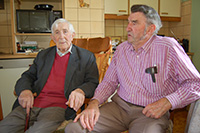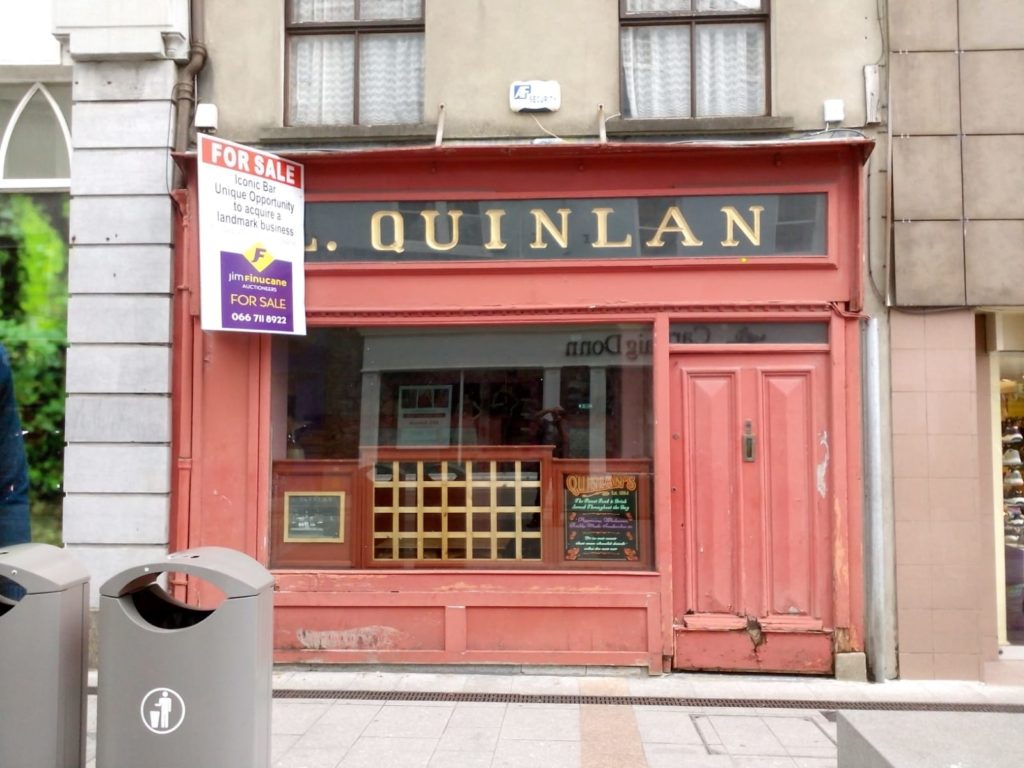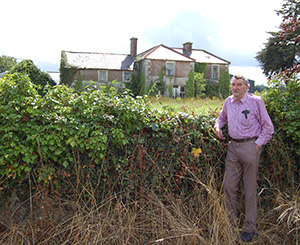The following account of the Quinlans of Kilcow and Farran is given by Michael O’Donohoe Memorial Project Chairman, John Roche, author of Born for Hardship:
Three Quinlan brothers were among the first group arrested within days of the Coercion Bill becoming law in the House of Commons in 1881. The eldest, William, was taken to Kilmainham gaol with Edmond Hussey, Terence O’C Brosnan, P D Kenny and possibly others, while Pat and Laurence Quinlan were lodged in Limerick prison with a number of others from the area.
Laurence was 15 years old and Pat 18 but they didn’t protest their youthfulness at the time.[1] Their father, Maurice Quinlan (my great grandfather) who was then chairman of the Tralee/Castleisland District Board of Guardians, contacted the MP, Healy, and he raised the matter in Parliament, much to the embarrassment of the authorities.[2] Laurence was released forthwith but I’m not sure when Pat was released.
About a year after this, William was given compassionate leave when his brother Michael died at home and when he was at the railway station, returning to Dublin, he got word that he was pardoned.[3]
William is mentioned twice in T M Donovan’s A Popular History of East Kerry about the period and was recognised as one of the Land League/Moonlighter leaders.[4] A great friendship developed between his group and Parnell in Kilmainham, hence Parnell’s reply, when asked who would replace him, ie Captain Moonlight! Edmond Hussey was vice-captain at the time. The friendship lasted and the Quinlan brothers were on the platform with Parnell whenever he went to the southwest.
‘The victors write the history’ and so there is very little record of the achievements of the Castleisland Land League/Moonlighters, which were summed up by TM Donovan that within one year, evictions were history in the Castleisland region.
Official references to the period written by landlords and police only highlight the individual atrocities, to be condemned of course, but which on the most part were carried out by individuals using the Land League as cover, that is, private feuds.

The real work of the Castleisland League/Moonlighters was monumental in that it led directly to the ending of evictions and land-grabbing throughout the nation plus reductions in rent, the ending of rack-renting, the passing of acts of parliament that allowed the people of Ireland to own, buy and sell property, as we still know it today. After 135 years, it is right that we start to recognise it.
The Quinlan brothers were from a long established family in the area. Their grandfather, Michael Lawrence Quinlan (1798-1860) of Kilcow was vice-chairman of the Board of Guardians during the famine time and their father, Maurice (1827-1892) later became chairman as well as chairman of the Irish National League in Currow/Castleisland and Captain Moonlight after Bob Finn left for Australia.[5]
Pat (P M Quinlan) was appointed Clerk of the Union and became first secretary/manager of the newly formed Kerry County Council.[6] He was succeeded by his son Michael, who died in the terrible flu of 1918. He was succeeded in turn by his brother Willie Quinlan, who retired as County Manager in 1953.
Other Quinlan descendants have been prominent in our national army and I believe that Commandant Pat Quinlan of Congo fame and the recent film is of the same family.
They are but one family of the many who achieved so much for so many by people power and I firmly believe that if the country had remained united behind Parnell, as did the Castleisland Land Leaguers, they would have achieved 32 county home rule by the turn of the twentieth century, one hundred years after the Act of Union and long before Carson was heard of.[7]

The Quinlan family residences were at Kilcow – a thatched single story building of which nothing remains – and Farran, which is in the ownership of the McCarthy family.[8]

_____________
[1] Laurence Quinlan never married. He emigrated to South Africa for some years in the early twentieth century but returned to Ireland and purchased a public house in Bridge Street, Tralee. The name L Quinlan still appears on the property. [2] The following communications between Hugh O H Hill and Heffernan Considine RM about Maurice Quinlan appear in the Considine Papers (National Library of Ireland) and reveal the temper of the times. They followed a complaint made by Maurice Quinlan that he had been stopped by a patrol. Statements about this incident were made by the police as follows: Castleisland 25 Nov 1882 I beg to state that I was on patrol duty with Sgt Dunne and Carty on 22nd inst when about two miles from Castleisland at Kilcow about 7.30pm we heard a car coming towards us and persons speaking as if they were drunk. When they came to where we were Sgt Dunne halted them for the purpose of taking their names. The reply he got from the driver was to kiss his backside and go to hell which he repeated several times. Sgt Dunne then told him he would arrest him if he did not tell his name. After some time he told his name was William Quinlan of Farran. His father, Maurice Quinlan, then got off the car and attempted to strike Sgt Dunne with a whip he had in his hand and called us a lot of moonlighters and said we were committing all the outrages in the county and protecting Tom Hurley the souper, he then fell against the ditch being drunk at the time. Sgt Dunne told his son William to take him home and that he would summons him for drunkenness. James Casey (Sergeants Joseph Carthy and Michael Dunne made similar statements). The following reveals how the police generally regarded the Quinlan brothers: Quinlans 3 sons were confined under the PPP Act 81 for nearly 12 months and are about the worst boys in this part of the country. Quinlan himself, when sober, is one of the most inoffensive men in the community. Under the all the circumstances I think it would be as well to let the matter drop and not institute any proceedings. Mr Davis is of the same opinion, when Quinlan was speaking to him he had the appearance of having drink taken but he could not swear he was drunk. However, it would have been perfectly possible for him to have been drunk at the time he met the patrol and be in the state he was in when he met Mr Davis. Hugh O H Hill. It appears no action was taken against Maurice Quinlan: Tralee 3 December 1882 Under the circumstances alluded to I think there is no necessity for further proceedings in this matter. H Considine Esq RM [3] ‘Mr William Quinlan of Castleisland was on Monday allowed out on parole for a week to see a member of his family who is lying dangerously ill’ (Kerry Evening Post, 31 May 1882). Michael M Quinlan, second son of Mr Maurice Quinlan, Farran, Castleisland, died at his father’s residence on 1 June 1882 aged 20. Funeral held at Ardcrone Church. [4] William Quinlan, rate collector for the Castleisland district, died suddenly from heart disease at Farran, Castleisland, in April 1893. He had taken over the duties from his late father, Maurice. [5] Maurice Quinlan died at his residence, Farran, on 3 April 1892 aged 65. His daughters were Norah, who married William Dowling, LPSI, Tralee, at St John’s Church Tralee on 29 November 1894; Mary, who married John Roche of Firie (from whom is descended John Roche, chairman of the Michael O’Donohoe Memorial Heritage Project, Castleisland) and youngest daughter, Katherine, who married Dr J M Murphy of the Farranfore dispensary district, son of Michael Murphy, Brosna, on 8 November 1906 at Mt St Alphonsus, Limerick. Maurice Quinlan hailed from a large family. Among his siblings were Mrs Pembroke (1824-1900); Laurence, who farmed at Kilcow; William (died at Kilcow 21 June 1883); Pat, a medical officer in India; Lt Col Michael of the Indian Medical Services, awarded VC; Kate (1838-1858), Miss Quinlan (alive in 1900); John (alive in 1900); Lt Col James (1832-1894). Their father, Michael Lawrence Quinlan, who married Nora Prendiville, was son of John Quinlan of Kilcow and Roxborough or Roxburgh, Molahiffe (who married Mary McDonald), son of Laurence of Roxborough, son of Maurice, chieftain, of Roxborough. The O’Quinlans came to Kerry c1173 from Meath/Westmeath. O’Quinlan commanded Malachy’s bodyguard at the Battle of Clontarf 1014 AD. Founder of the clan died 925 AD, buried at the Abbey of Fore. Anciently Laoghaire (King of Ireland at Tara) was eldest son of Niall of the Nine Hostages, in direct line from Hermon, first Milesian King of Ireland, whose mother Scotia was killed at the Battle of Sliabh Mis 3000 years ago – Ua Caoindealbhain 15th in senior line from Laoghaire. [6] Patrick M Quinlan of The Kerries, Tralee, died on 11 October 1918 aged 56. [7] John Roche by email, 7 November 2016. Further reference, 'Castleisland – Home of the Moonlighters' by John Roche, Collection Ref IE MOD/A20/2 (26). [8] Information regarding Kilcow provided courtesy Pat Mahony, Kilcow. Farran House, Castleisland, is omitted from Valerie Bary’s Houses of Kerry. The date of construction is not known. Maurice Quinlan was in residence in 1861; the lands appear to have been held by the Herbert family. Garrett McCarthy purchased Farran in about 1912. He died in 1960: ‘The death of Mr Garrett McCarthy, Peace Commissioner of Farran, Castleisland, has removed one of the best known farmers in the East Kerry territory. The late Mr McCarthy had spent much of his early life in South Africa as a railroad builder. He was personally acquainted with the late Cecil Rhodes and frequently executed contracts under his direction in South-east Africa. Three other brothers were also engaged in similar work in the territory at the turn of the century. During the troubled times his house was often used as a refuge by the members of the IRA. The late Mr McCarthy was one of the first Peace Commissioners to be appointed at the establishment of the Free State’ (Irish Examiner, 16 January 1960). The property has been unoccupied for about 30 years and is falling into disrepair.


